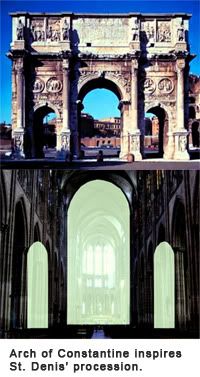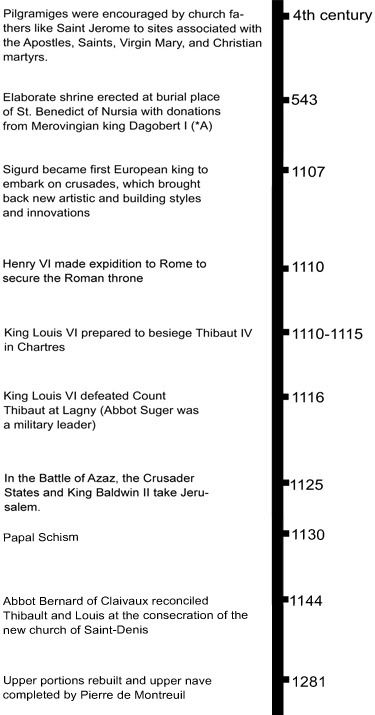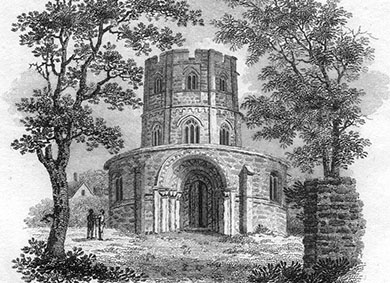Saint Denis Basilica, built under the supervision of Abbot Suger, heralded Europe’s shift from Romanesque to Gothic. The difference can be seen in its pointed arch, the ribbed vault, the ambulatory with radiating chapels, the clustered columns supporting ribs springing in different directions and the flying buttresses which enabled the insertion of large clerestory windows.
|
 |
Values
Clean up corruption among monks
In the 1120’s, Peter Abelard called the abbey at Denis “completely worldly and depraved,” and accused the monks of “intolerably foul practices, both in private and in public.” a Abbot Suger was determined to reform the Benedictine Order at Saint-Denis.
The monks were harassed by politicians and invaders, and often became “grand and profane” and struggled to receive classical learning. b Saint Denis provided a place for this reformation.
Reconcile mystery and opulent materiality
“The ‘easy and concordant harmony’, or the ‘miraculous peace’ that Augustine saw as the primitive condition of the unfallen human nature, will only be restored, both in the individual person and in human society, in the heavenly society, in the heavenly City of the saints…. Not that monks were immune to the effects of original sin, or a monastic community exempt from its disruptive social consequences; but in the monastic community Augustine saw a kind of prefiguring of the heavenly City….
The monastery, far from providing the model for other societies, defined the permanent challenge to all other forms of social existence.” c
The church and monastary became the center of the city both culturally and socially.
Less initial demands for style
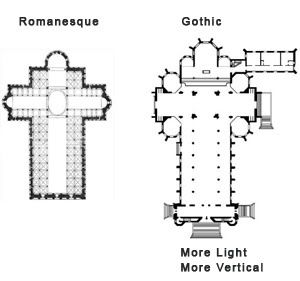 Though Romanesque churches were popular elsewhere in Europe, the Ile-de-France never had a firm style to build on. Because of this there were less assumptions made about what a church should be and a new emphasis on local traditions led to uniqueness and inovation.
Though Romanesque churches were popular elsewhere in Europe, the Ile-de-France never had a firm style to build on. Because of this there were less assumptions made about what a church should be and a new emphasis on local traditions led to uniqueness and inovation.
“The growth of the royal power which made Paris the centre of a more powerful kingdom, the growth of the towns and the encouragement by the king of the communes as a balance to his more powerful nobles, all tended to the spread of local patriotism…. The bishops were thus in a position to take advantage of the opportunity to stir up popular enthusiasm for each town or commune to strive with its neighbors as to which could build the finest church.” d
Liberation from gravity
Gothic was a “transormation of stone into something light and airy” while in Romanesque “the stones are there simply to hold the building up” e “Vaults are supported by surprisingly slim columns… windows reach almost to the floor, creating what Suger called a ‘crown of light.’ Wilhelm Worringer called this a “vertical ecstasy.” f
Rib vaults date back to 1100 in Normandy. Pointed arches were found in Normandy and Burgundy. Cylindrical columns were in ancient Rome in Egypt before that. St. Denise derived the triple portal of the west front from the arch of Constantine in Rome. The innovative rose window on the front façade of St Denis echoed the Roman Arch of Constantine which had a three-part division and three large portals to ease the problem of congestion.
The architect pulled many things from international sources to make something completely new.
Enlarge the volume using a modular principle
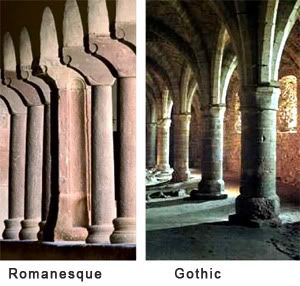
Honest forms, less ornamentation
The modern vault could be repeated to create a bay. It’s units are segmented by windows, similarly to how the Romans treated their temples. Rational modulation opened new possibilities in form.
Cistercian abbot Bernard of Clairvaux lamented “the measureless height of the houses of prayer, their exaggerated length, their useless width, the amount of stonemasons’ work they involved, their paintings which stimulate curiosity and disturb prayer.’” g
Suger’s solved this by reducing the the extravagance and exaggeration, cleaning up the lines to their minimal essence and pushing this harmonious form further. The new style would be less grandiose, more profound.
Be like ancient Rome
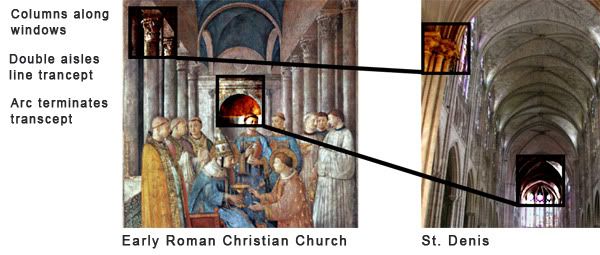 Carrying on this Romanesque value, the Gothic looks back to the lost fathers of learning in Rome and Greece for knowledge and wisdm.
Carrying on this Romanesque value, the Gothic looks back to the lost fathers of learning in Rome and Greece for knowledge and wisdm.
“A new nave was also projected, but its construction never progressed beyond the foundations, the remains of which indicate that it would have been atypical for its period in having double side aisles and columnar supports, characteristics that were probably meant to evoke earlier churches either in Rome (e.g. Old Saint Peter’s) or in Paris itself” h
Fresh confidence in the monarchy and church
“[Saint-Denis] had been the royal abbey since Charlemagne’s grandson Charles the Bald became lay abbot in 867, and as such it was the spiritual heart of the state.”
“[Suger] intended to imply a link between these biblical rulers and the monarchs of Suger’s contemporary France, legitimizing the idea that it was France, not Germany, that was the true spiritual home of Christianity in the West.”
“Undertaking the construction of such a model demanded an intellectual and theological confidence that did not exist in Christendom until the twelfth century.” i
Historian Georges Duby: “The eleventh-century Christians still felt utterly crushed by mystery, overwhelmed by the unknown world their eyes could not see… Man felt as if surrounded by thick bushes, somewhere in them God was concealed.” j
Moderate political alliances
Suger sought political conciliation and negotiation between the French Kings and the papacy. Cathedrals would help achieve this unity and build upon France’s recent victories over political rivals in Germany and England. “In 1124, ‘on the advice of the English king, Henry’ Emperor Henry V ‘was plotting a surprise attack against the city of Reims.’… Others go as far as to claim that Louis’s stand against Henry V in 1124 is the ‘first expression of national patriotism in France’. According to Suger, Louis’s army consisted of an impressive list of royal vassals and allies…
‘France has done nothing more renowned than this deed, either in modern times or in the distant past. And she has never displayed the splendor of her power more gloriously than when she united the strength of her members and triumphed at the very same time over the Roman emperor and, although King Louis was absent, the English king.’” k
The construction of Saint Denis and other large churches helped bring peace between France and the Vatican. Local unfriendly rulers, like Henry’s relative Thibaut, were pacified and united under a single ruler.
Unity of space and experience
The building emphasizes relationships of parts toward a total unity. Each detail reinforces an over-arching vision: ”It is the facade of Saint-Denis that marks the beginning of a new epoch… In the facade of Saint-Denis the three doorways are fused into a unity by the slight predominance of the central one, and by the uniform use of all-round figures in the jambs…. the three doorways are incorporated into the vertical system of the facade with its towers; we see the horizontal unity of the lower part simultaneously with the unity of the whole facade.
In Romanesque buildings the subjects of sculpture are loosely strung together, and chosen quite haphazardly. In Saint-Denis they are based on a coherent theological plan, and each piece of sculpture is part of that plan.” l
This coherent language helped bring together groups of people: ”…Gothic design articulated spatial and spiritual unity in a social world increasingly divided into a multiplicity of groups, whose tensions crossed the political, social economic, and cultural spectrum… in a setting which was both a space of unity and an instrument of coercion.” m
Reveal the invisible universe
As a neo-Platonic celestial Jerusalem, the cathedral sought to reveal the invisible nature of the universe with symbolism. Unlike how we understand symbolism today, Gothic symbolism avoided mimicry. It used color, proportion, and other design elements to convey a moral reality.
The physical building pointed people to the idealistic principles of heaven. Not only does man’s technology dominate nature, it produces a moral reality, a higher state. Like how the monks renounced the physical world with its inherent misery and uncleanliness, the united community at large could seek toward this goal. But the cathedral did not renounce nature, it simply changed the discussion about nature’s meaning:
“Even at its most dreadful, nature appeared to the symbolical imagination to be a kind of alphabet through which God spoke to men and revealed the order of things, the blessings of the supernatural, how to conduct oneself in the midst of this divine order and how to win heaven. In themselves, things might inspire distrust because of their disorder, their frailty, their seeming hostility. But things were more than they seemed. Things were signs. Hope was restored to the world because the world was God’s discourse to man.” n
Glorify the royal burial site & Solidify the Bishop’s power
Grand displays of wealth glorified the powers behind the cathedral. Suger used gold, jewels, and colorful glass as a propaganda device. Some criticized Suger for “the rich art in his church by those who opposed his use of precious materials and the making of opulent displays. Suger’s artistic program for Saint-Denis seemed overtly sensual to some…” o
Inscribed on the very doors of Saint-Denis, Suger claimed these rich displays helped reveal the invisible universe and guide people to the unseen reality: “Marvel not at the gold and the expense but at the craftsmanship of the work; Bright is the noble work; but, being nobly bright, the work should brighten the minds, so that they may travel through the true lights, to the True Light where Christ is the true door. In what manner it be inherent in this world the golden door defines: The dull mind rises to truth through that which is material and, in seeing this light, is resurrected from its former submersion.” o
The word “Cathedra” means chair or throne of the Bishop. p
As local economies grew and regional leaders became more important to the national unity, the bishop seat became more and more powerful. The cathedral’s wealth came to represent that power.
Less mystical
Mysticism was an important part of Suger’s vision. “Suger was heavily indebted to his reading of certain mystical treatises written by Dionysius the Areopagite (whom Syger and many of his contemporaries wrongly assumed was the Saint Denis for whom the abbey was named), a fifth-century Syrian monk whose works on mystical theology were strongly influenced by Neo-Platonic philosophers as well as by Christian doctrine.” r Suger saw the purity of light as the destination for the hierarchy of matter.
But mysticism was tempered by rational thought and reasoning. The modern structural forms and architectural methods in Saint Denis contributed to a paradigm shift where the people became less mystically minded and more scientific.
Facilities for pilgrims
“It facilitated the circulation of pilgrims who came came to see the relics.” s
“According to an 11th-century legend, the old church had been consecrated by Christ himself; it was thus considered a holy relic and its structure technically inviolable: to avoid criticism Suger obviously took pains not to demolish it all at once.” t

(Claude Attard– flickr/creative commons license)
Site: Burial Place of Saint Denis
In the 7th century, at the burial place of Saint Denis, Eligius “fabricated a mausoleum for the holy martyr Denis in the city of Paris with a wonderful marble ciborium over it marvelously decorated with gold and gems. He composed a crest [at the top of a tomb] and a magnificent frontal and surrounded the throne of the altar with golden axes in a circle. He placed golden apples there, round and jeweled. He made a pulpit and a gate of silver and a roof for the throne of the altar on silver axes. He made a covering in the place before the tomb and fabricated an outside altar at the feet of the holy martyr. So much industry did he lavish there, at the king’s request, and poured out so much that scarcely a single ornament was left in Gaul and it is the greatest wonder of all to this very day.” u
Rise of the Monasteries
St. Benedict established monasteries: “To establish due order, to foster an understanding of the relational nature of human beings, and to provide a spiritual father to support and strengthen the individual’s ascetic effort and the spiritual growth that is required for the fulfillment of the human vocation, theosis.” v
Architect’s Statements
Cleaning up corruption and glorifying royal image:
“We resolved to hasten with all our soul and the affection of our mind, to the enlargement of the aforesaid place – we who would never have presumed to set our hand to it, nor even to think of it, had not so great, so necessary, so useful and honourable an occasion demanded it.” (Abbot Suger, De consecratione)
The revitalization of this monastic complex resulted in this desired result among the clergy. But is that really what Suger set out to do, or were political motivations more important and was he just post-rationalizing?
The opulence he put into the building ran counter to the humbleness and material poorness that Bernard demanded is necessary to clean up religious corruption.
Creating social unity:
“Of the diverse counts and nobles from many regions and dominions, of the ordinary troops of knights and soldiers [at the building’s consecration] there is no count.” (Abbot Suger, De consecratione)
So this is a building for every person? Something democratic? No. It does indicate, however, that the building was instantly relevant among all classes in the society… If what he says is correct.
Cleaning up corruption:
St. Bernard to Suger in a 1127 letter: “It was your errors, not at those of your monks, that the zeal of the saintly aimed its criticism. It was by your excesses, not by theirs, that they were incensed.” w
Bernard praised Suger for his achievement in revitalizing the monastary.
Recently Completed Buildings

Cathedral in Chartres, FranceBy Bishop Fulbert |
The Holy Sepulchre, CambridgeBy 11th century Crusaders |
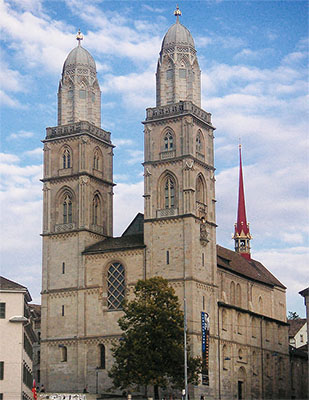 |
Grossmünster Cathedral, ZurichOriginally comissioned by Charlemagne |
Related Artists, Architects, Scientists
Bishop Fulbert – Commissioned Chartres Cathedral in 1020, requested funds from the King and other sources.
Beranger – Fulbert’s architect for Chartres, who built with a Gothic plan as constrained by the early Romanesque structure, setting a precedence in Gothic for respecting previous styles.
Geoffrey de Leves – Friend and influence on Abbot Suger. “In the magnificence of the western entrance that Geoffrey commissioned we can see a portent of what Suger had in mind for his own church when he began reconstruction in 1137.” [x]
St. Bernard – Established a center for Cistercian Order of monks, and demanded humble simplicity. He became extremely influential and conducted political negotiations which involved Saint-Denis and led to its role. “…We know that peace negotiations were pursued at the consecration of the new choir, because St. Bernard wrote to Jocelyn of Soissons that he hoped to see him to prosecute them at a forthcoming appointed celebration, an ‘indicta celebritate’, at St. Denis.” [y] Influenced St. Denis.
Eligius – A goldsmith by training, worked on many churches and cathedrals including St. Denis.
Nicholas of Verdun – 1180-122 Goldsmith and Enamellist for the Shrine of the Three Kings at Cologne Cathedral.
Gerard of Cremona – Translated many texts in the 12th century, especially from Arabic and Latin, to expand the learning and philosophy of Europe.
Master Hugo – 1130-c.1150 Romanesque lay artist, made illustrations for the bible, made bronze doors for the western entry of the Abbey church.
Gislebertus – 1120-1135 French Romanesque sculptor. He worked on the Cathedral of Saint Lazare at Autun, France – made expressive doorways, tympanums, and capitals.
Saint Anselm of Canterbury – 1033 – 21 Benedictine monk, an Italian medieval philosopher, theologian, and church official. Founder of scholasticism.
Saint Denis – 250 Christian martyr and venerated saint. A third century Bishop of Paris.
Eastern Influence:
Ibn Sīnā – 980 Completed 46 works on philosophy, medicine, theology, geometry, and astronomy. About 99 other influencial books can be attributed to Ibn Sina.
Abu Rayhan Biruni – Founder of Indology, the father of geodesy, and “the first anthropologist”. One of the earliest leading exponents of the experimental scientific method, particularly for mechanics and mineralogy, a pioneer of comparative sociology and experimental psychology, and the first to conduct elaborate experiments related to astronomical phenomena.
Alhazen – Contributed to the principles of optics, to anatomy, astronomy, engineering, mathematics, medicine, ophthalmology, philosophy, physics, psychology, visual perception, and to science in general with his introduction of the scientific method.
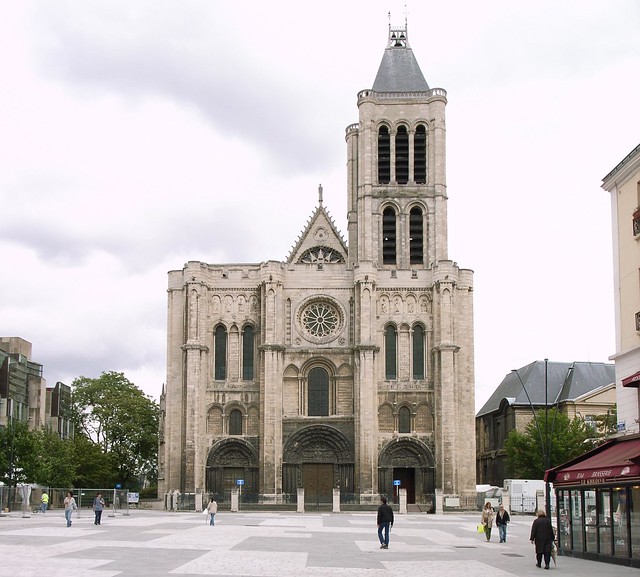
(stevecadman– flickr/creative commons license)
Summary
People had new hope in their clergy and government, the economy picked up, international influences, and greater values for learning and rationalsim led to the magnificent form. The historical struggle against corruption and mystic fear came to an end and a new struggle against opulence and worldly realities began.
The immensely popular Abbot Suger, who had served as a military leader for the king, put immense effort in the Saint Denis Basillica for the purpose of glorifying the nation and reforming the religious structure.
The highly modern structure used technical innovations from far away to do something that had rarely been sought in architecture: to let architecture contribute to the program rather than just providing shelter and open space. The architecture let in more light, it gestured the people toward the heavens, but most importantly it established itself as a very real symbol for the unseen world, for the moral and theological reality that couldn’t be seen in nature.
People gained courage, and they became less content with not knowing the truths of their environment.
© Benjamin Blankenbehler 2011
Citations:
- ^“The Letter Collection of Peter Abelard and Heloise” by David Luscombe Oxford University Press, 2013: p.51
- ^Encyclopedia of the Middle Ages” by André Vauchez, Richard Barrie Dobson, Adrian Routledge, 2000: p.973
- ^“Saeculum: History and Society in the Theology of St Augustine” by R. A. Markus Cambridge University Press, 1988: p.xv
- ^“An Introduction to French Church Architecture” by Philip Ball Arthur Gardner, 2012: p.43
- ^“Universe of Stone- A Biography of Chartres Cathedral” by Philip Ball HarperCollins, 2008: p.28
- ^“Universe of Stone- A Biography of Chartres Cathedral” by Philip Ball HarperCollins, 2008: p.42
- ^“Beauty Awakening Belief: How the Medieval Worldview Inspires Faith Today” by Jon M. Sweeney Church Publishing, Inc., 2009: p.94
- ^“Saint-Denis Abbey” by Stephen Gardner Grove Dictionary Of Art, 2009
- ^“Universe of Stone- A Biography of Chartres Cathedral” by Philip Ball HarperCollins, 2008: pp.36
- ^“Triumph of the Midieval Mind” by Philip Ball. Nature: International weekly journal of science, 2008
- ^“Studies in Medieval History, Volume 16; Volume 2005” by Stephen Morillo, Diane Korngiebel Boydell Press, 2006: pp.62,65quoting from Suger, The Deeds of Louis the Fat, trans. R. Cusimano and J. Moorehead (Washingto, D.C. 1992), 127 and 132
- ^“Gothic Architecture” by Paul Frankl Yale University Press, 2000: p. 62
- ^“Artistic Integration in Gothic Buildings” by Virginia Chieffo Raguin, Kathryn Brush, Peter Draper University of Toronto Press, 1995: p. 225
- ^“Art and Beauty in the Middle Ages” by Umberto Eco Yale University Press, 2002: p.54
- ^“The Substance of Things Seen: Art, Faith, and the Christian Community” by Robin Margaret Jensen Wm. B. Eerdmans Publishing, 2004: p.81
- ^“Cathedra” Wikipedia, the free encyclopedia, 2009
- ^“Culture and Values: A Survey of the Humanities, Comprehensive Edition: A Survey of the Humanities, Comprehensive Edition (with Resource Center Printed Access Card)” by Lawrence S. Cunningham, John J. Reich Cengage Learning, 2009: p.215
- ^“Universe of Stone- A Biography of Chartres Cathedral” by Philip Ball HarperCollins, 2008: pp.42
- ^“Saint-Denis Abbey” by Stephen Gardner Grove Dictionary Of Art, 2009
- ^“Medieval Hagiography: An Anthology” by by Thomas Head. Routledge, 2001: pp.150
- ^“Wiki: Rule of Saint Benedict” Wapedia, 2009
- ^“From the rise of Athens through the 17th century” by Frank Roy Willis, Heath, 1973: p.274 HarperCollins, 2008
- ^“Universe of Stone- A Biography of Chartres Cathedral” by Philip Ball HarperCollins, 2008: pp.20
- ^“Anglo-Norman Studies XIX: Proceedings of the Battle Conference” by Christopher Harper-Bill Boydell & Brewer Ltd, 1997: p.61

